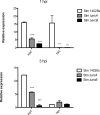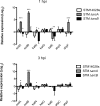The ArcAB two-component regulatory system promotes resistance to reactive oxygen species and systemic infection by Salmonella Typhimurium
- PMID: 30180204
- PMCID: PMC6122832
- DOI: 10.1371/journal.pone.0203497
The ArcAB two-component regulatory system promotes resistance to reactive oxygen species and systemic infection by Salmonella Typhimurium
Erratum in
-
Correction: The ArcAB two-component regulatory system promotes resistance to reactive oxygen species and systemic infection by Salmonella Typhimurium.PLoS One. 2019 Mar 26;14(3):e0214634. doi: 10.1371/journal.pone.0214634. eCollection 2019. PLoS One. 2019. PMID: 30913267 Free PMC article.
Abstract
Salmonella enterica Serovar Typhimurium (S. Typhimurium) is an intracellular bacterium that overcomes host immune system barriers for successful infection. The bacterium colonizes the proximal small intestine, penetrates the epithelial layer, and is engulfed by macrophages and neutrophils. Intracellularly, S. Typhimurium encounters highly toxic reactive oxygen species including hydrogen peroxide and hypochlorous acid. The molecular mechanisms of Salmonella resistance to intracellular oxidative stress is not completely understood. The ArcAB two-component system is a global regulatory system that responds to oxygen. In this work, we show that the ArcA response regulator participates in Salmonella adaptation to changing oxygen levels and is also involved in promoting intracellular survival in macrophages and neutrophils, enabling S. Typhimurium to successfully establish a systemic infection.
Conflict of interest statement
The authors have declared that no competing interests exist.
Figures







Similar articles
-
Linearized Siderophore Products Secreted via MacAB Efflux Pump Protect Salmonella enterica Serovar Typhimurium from Oxidative Stress.mBio. 2020 May 5;11(3):e00528-20. doi: 10.1128/mBio.00528-20. mBio. 2020. PMID: 32371597 Free PMC article.
-
FNR is a global regulator of virulence and anaerobic metabolism in Salmonella enterica serovar Typhimurium (ATCC 14028s).J Bacteriol. 2007 Mar;189(6):2262-73. doi: 10.1128/JB.00726-06. Epub 2007 Jan 12. J Bacteriol. 2007. PMID: 17220229 Free PMC article.
-
Activation of regulator ArcA in the presence of hypochlorite in Salmonella enterica serovar Typhimurium.Biochimie. 2021 Jan;180:178-185. doi: 10.1016/j.biochi.2020.11.009. Epub 2020 Nov 12. Biochimie. 2021. PMID: 33188860
-
The metabolic pathways utilized by Salmonella Typhimurium during infection of host cells.Environ Microbiol Rep. 2018 Apr;10(2):140-154. doi: 10.1111/1758-2229.12628. Epub 2018 Feb 23. Environ Microbiol Rep. 2018. PMID: 29411544 Review.
-
The invasion-associated type III secretion system of Salmonella typhimurium: common and unique features.Cell Mol Life Sci. 2000 Jul;57(7):1033-49. doi: 10.1007/PL00000743. Cell Mol Life Sci. 2000. PMID: 10961343 Free PMC article. Review.
Cited by
-
The ArcAB two-component system is associated with the susceptibility of Aggregatibacter actinomycetemcomitans to superoxide and hydrogen peroxide.mSphere. 2025 May 27;10(5):e0001925. doi: 10.1128/msphere.00019-25. Epub 2025 Apr 16. mSphere. 2025. PMID: 40237472 Free PMC article.
-
Implication of the σE Regulon Members OmpO and σN in the ΔompA299-356-Mediated Decrease of Oxidative Stress Tolerance in Stenotrophomonas maltophilia.Microbiol Spectr. 2023 Aug 17;11(4):e0108023. doi: 10.1128/spectrum.01080-23. Epub 2023 Jun 7. Microbiol Spectr. 2023. PMID: 37284772 Free PMC article.
-
The Transcription Factor ArcA Modulates Salmonella's Metabolism in Response to Neutrophil Hypochlorous Acid-Mediated Stress.Front Microbiol. 2019 Dec 5;10:2754. doi: 10.3389/fmicb.2019.02754. eCollection 2019. Front Microbiol. 2019. PMID: 31866961 Free PMC article.
-
A comparative analysis of peptide-delivered antisense antibiotics using diverse nucleotide mimics.RNA. 2024 May 16;30(6):624-643. doi: 10.1261/rna.079969.124. RNA. 2024. PMID: 38413166 Free PMC article.
-
Who's in control? Regulation of metabolism and pathogenesis in space and time.Curr Opin Microbiol. 2020 Jun;55:88-96. doi: 10.1016/j.mib.2020.05.009. Epub 2020 Jun 9. Curr Opin Microbiol. 2020. PMID: 32532689 Free PMC article. Review.
References
Publication types
MeSH terms
Substances
LinkOut - more resources
Full Text Sources
Other Literature Sources
Medical

